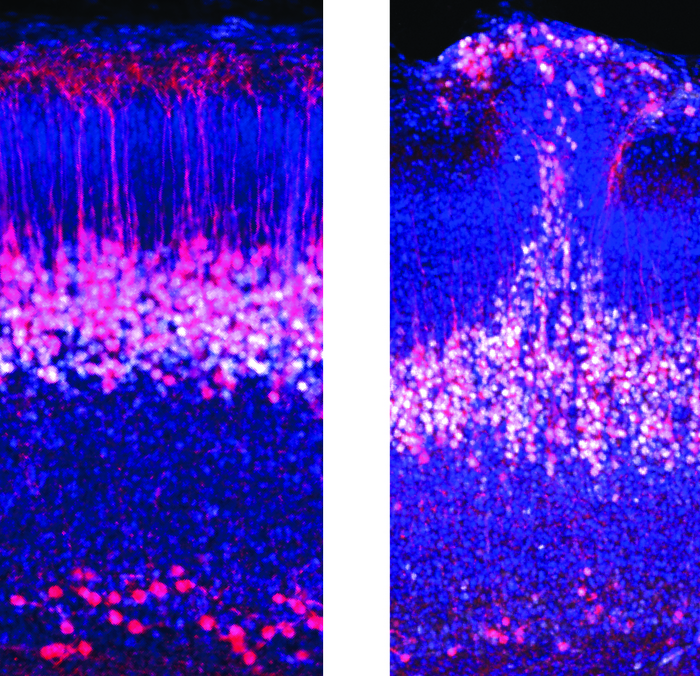Reviewed by Danielle Ellis, B.Sc.Apr 18 2023
Researchers have discovered an active multi-layer circuit that emerges in the cortex at an unexpectedly early stage of development using a new method for analyzing live embryonic mouse brains at single-cell resolution.

Layer 5 pyramidal neurons in normal mice (left) compared with mice with autism gene knocked-out (right), showing a patch of disorganized cortex. Image Credit: Institute of Molecular and Clinical Ophthalmology Basel (IOB)
Changes to the circuit brought forth by genetic modification resembled those in autistic people’s brains. A team of researchers from the Institute of Molecular and Clinical Ophthalmology Basel published the results in the journal Cell on April 17th, 2023.
Understanding the detailed development of cell types and circuits in the cortex can provide important insights into autism and other neurodevelopmental diseases. This is what our findings confirm.”
Botond Roska, Director, Institute of Molecular and Clinical Ophthalmology Basel
The cortex, the area of the brain that controls sensory perception, cognitive abilities, and other high-order activities, has long been associated with autism. Pyramidal neurons, which are excitatory cells, make up the majority of the cortex.
It was challenging for the IOB team to investigate when and how these neurons come together to form the first active circuits in the cortex.

Image Credit: whitehoune/Shutterstock.com
Pyramidal neurons are barely one-tenth as wide as a human hair, therefore even the slightest movement during an experiment could end up in erroneous activity recordings. The scientists came up with a surgical method to preserve the neurons’ stability throughout research: embryos were placed inside 3D holding devices filled with agar within the mother’s abdominal cavity to maintain the normal embryonic blood flow and temperature.
According to the prevailing theory, the cortex grows “inside out fashion,” with the deepest of its six layers emerging first. Pyramidal neurons were believed to gradually activate as they go to their final locations in the brain and link with one another.
We actually detected a very different activity pattern.”
Arjun Bharioke, Study Co-Lead Author and Systems Neuroscientist, Central Visual Circuits Group, Institute of Molecular and Clinical Ophthalmology Basel
The scientists found a very early transient circuit that was already very active and correlated even before the six-layer cortex had developed, focusing primarily on pyramidal neurons that mature into layer 5 of the cortex. This suggests that the neurons were already interconnected before moving to create layer 5.
Initially, the transient circuit included two layers: a deep layer and a superficial layer. Later, the superficial layer went quiet and disappeared, and the cortical growth proceeded as usual layer by layer, with a third intermediate layer becoming layer 5 in the process.
We also wanted to understand how this circuit changes in an autism model.”
Martin Munz, Study Co-Lead Author and Developmental Biologist, Central Visual Circuits Group, Institute of Molecular and Clinical Ophthalmology Basel
The scientists discovered a significant discovery when working with knock-out mice lines lacking one or both alleles of the two genes Chd8 and Grin2b linked to autism. These genes are known to significantly increase a child’s risk of autism.
The superficial layer also continued to function as a developmental remnant in homozygous and heterozygous knockout mice.
Munz added, “Throughout embryonic development, it never disappeared.”
Additionally, the knockout mouse brains had patchy regions of cortical disarray akin to what is found in people with autism.
The results show that the newly discovered circuit controls the spatial structure of pyramidal neurons.
Bharioke stated, “Changes to embryonic circuits play a role in dysfunctions associated with neurodevelopmental disorders, including autism spectrum disorder.”
According to Roska, the researcher will “carefully look at the superficial and deep layers of this early circuitry and independently manipulate them. This will be instructive for learning about the etiology of neurodevelopmental diseases.”
Source:
Journal reference:
Munz, M., et al. (2023). Pyramidal neurons form active, transient, multilayered circuits perturbed by autism-associated mutations at the inception of neocortex. Cell. doi.org/10.1016/j.cell.2023.03.025